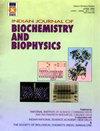FUSE binding protein1 interacts with Tumor Suppressor p53 and p53-Isoforms through their DNA Binding domain: Mapping the FBP1 binding site
IF 1.5
4区 生物学
Q4 BIOCHEMISTRY & MOLECULAR BIOLOGY
引用次数: 0
Abstract
We have earlier demonstrated that a cellular factor, FUSE binding protein1 (FBP1), physically interacts and effectively suppresses the function of tumor suppressor p53 and promotes persistent HCV replication [Dixit et al. JVI 89:7905, 2015). In the present study, we demonstrate that FBP1 interacts with various naturally occurring p53-isoforms isolated from different cancers that carry large deletions at the N- and C-terminal regions but still have an intact DNA binding domain (DBD). We discovered that FBP1 specifically interacts with the DNA binding domain (DBD) of p53 and its isoforms. We further mapped the FBP1-interaction site and identified a 21-residue-long motif spanning amino acid residues 163-183 in the p53-DBD. We further confirmed that Arg175/Cys176, within this motif, is necessary for FBP1 interaction. Arg175/Cys176, located at the junction of the β4 and H1 helix of the L2 Loop, is required for the DNA binding function of p53. Occupying this site containing Arg175/Cys176 by FBP1 may block the DNA binding function of p53.FUSE结合蛋白1通过其DNA结合域与肿瘤抑制因子p53和p53-异构体相互作用:绘制FBP1结合位点
我们之前已经证明了一种细胞因子,FUSE结合蛋白1 (FBP1),物理上相互作用并有效抑制肿瘤抑制因子p53的功能并促进HCV的持续复制[Dixit等]。Jvi 89:7905, 2015)。在本研究中,我们证明了FBP1与从不同癌症中分离出来的多种天然存在的p53-异构体相互作用,这些异构体在N端和c端区域携带大量缺失,但仍然具有完整的DNA结合域(DBD)。我们发现FBP1特异性地与p53及其同工异构体的DNA结合域(DBD)相互作用。我们进一步绘制了fbp1相互作用位点,并在p53-DBD中发现了一个21个残基长的基序,横跨163-183个氨基酸残基。我们进一步证实了该基序中的Arg175/Cys176是FBP1相互作用所必需的。Arg175/Cys176位于L2环的β4和H1螺旋的交界处,是p53的DNA结合功能所必需的。FBP1占据含有Arg175/Cys176的位点可能会阻断p53的DNA结合功能。
本文章由计算机程序翻译,如有差异,请以英文原文为准。
求助全文
约1分钟内获得全文
求助全文
来源期刊

Indian journal of biochemistry & biophysics
生物-生化与分子生物学
CiteScore
2.90
自引率
50.00%
发文量
88
审稿时长
3 months
期刊介绍:
Started in 1964, this journal publishes original research articles in the following areas: structure-function relationships of biomolecules; biomolecular recognition, protein-protein and protein-DNA interactions; gene-cloning, genetic engineering, genome analysis, gene targeting, gene expression, vectors, gene therapy; drug targeting, drug design; molecular basis of genetic diseases; conformational studies, computer simulation, novel DNA structures and their biological implications, protein folding; enzymes structure, catalytic mechanisms, regulation; membrane biochemistry, transport, ion channels, signal transduction, cell-cell communication, glycobiology; receptors, antigen-antibody binding, neurochemistry, ageing, apoptosis, cell cycle control; hormones, growth factors; oncogenes, host-virus interactions, viral assembly and structure; intermediary metabolism, molecular basis of disease processes, vitamins, coenzymes, carrier proteins, toxicology; plant and microbial biochemistry; surface forces, micelles and microemulsions, colloids, electrical phenomena, etc. in biological systems. Solicited peer reviewed articles on contemporary Themes and Methods in Biochemistry and Biophysics form an important feature of IJBB.
Review articles on a current topic in the above fields are also considered. They must dwell more on research work done during the last couple of years in the field and authors should integrate their own work with that of others with acumen and authenticity, mere compilation of references by a third party is discouraged. While IJBB strongly promotes innovative novel research works for publication as full length papers, it also considers research data emanating from limited objectives, and extension of ongoing experimental works as ‘Notes’. IJBB follows “Double Blind Review process” where author names, affiliations and other correspondence details are removed to ensure fare evaluation. At the same time, reviewer names are not disclosed to authors.
 求助内容:
求助内容: 应助结果提醒方式:
应助结果提醒方式:


